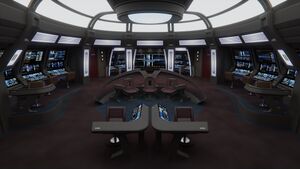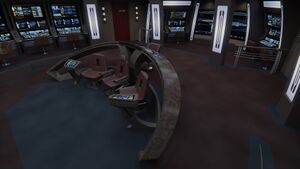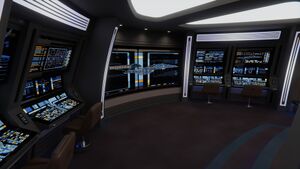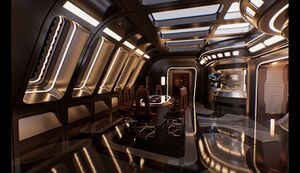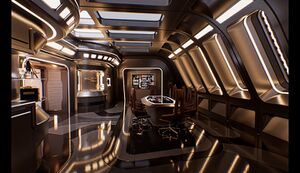USS Lakota
- "No mater where you go, there you are."
- —Buckaroo Banzai - Ship's Dedication Quote
USS Lakota is an Excelsior II-class heavy cruiser serving in the Fourth Fleet. As the fourth ship in its lineage, the Lakota carries on a proud name and legacy, representing a contemporary and versatile upgrade to the iconic Excelsior-class starships of yesteryear.
Mission Objectives
A multi-purpose starship well into her tour of duty, Lakota has completed a wide variety of tasks and missions assigned to her over the years. Some of her core duties, commensurate with her class as a whole, include:
- Operating autonomously under the command of the commanding officer, providing full capability to execute Federation defensive, cultural, scientific, and explorative policy in deep space or along border territories.
- Replacing aging starships in certain frontline diplomatic and exploration duties.
- Providing a platform for extended scientific survey and scouting missions.
- Providing frontline support during times of war or crisis, such as the Century Storm and Blood Dilithium situations, and situations diplomatic in nature.
- Serving non-critical functions such as transport of personnel and cargo when necessary, extended aid, and short-range patrol.
Technical Configuration
Main Article: Excelsior II-class Heavy Cruiser
Key Location Data
- Main Article: Lakota deck listing
- Main Article: Tour of the Lakota
With 24 decks, the ship has hundreds of rooms and locations that serve a variety of purposes for the crew. Some of the more notable locations include:
Bridge, Deck 1
Consisting of an amalgamation of successful features from both the Galaxy and Sovereign lineages, and also one major new addition, Lakota has one of the more unique bridge modules in the fleet. Importantly, it makes the most of a variety of technological advancements, such as holoprojectors, holographic communications, in-built weapons lockers and three-dimensional computer displays wherever possible.
In a move away from more recent styles, and harking back to the traditional layouts of yesteryear, Lakota has an ornately carved rail, known as The Arch, surrounding the command pit and housing a large tactical display used by members of the Tactical Operations Department for all offensive and defensive operations. In the command pit it surrounds, three chairs stand ready for the Captain, her Executive Officer (starboard) and a third seat (port), reserved for the use of the ship's Counsellor, Chief Medical Officer or any official or dignitary the Captain sees fit. Both chairs flanking the Captain have their own stand-alone consoles to enable the occupying officers to conduct their duties, whilst the command chair itself has control built into the arms on either side, allowing the Captain unprecedented control from the seat of command (although Nazir is much more of a traditionalist and will delegate tasks to others where possible).
Directly ahead of the command pit, at the bottom of the ramp and between the commanding officer and the holographic viewscreen, two angled consoles serve as duty stations for Operations (port) and Flight Operations (starboard). Next, and facing the main focal point of the viewscreen, are duty stations for science (port) and engineering (starboard). Around the outside of the bridge, there are countless other additional stations. Behind the main science station on the port bulkhead, additional science and medical consoles are available for mission operations, as well as access to life support. Adjacent to them on the starboard bulkhead, engineering is the focus with additional controls allowing the Chief Engineer access to the same engineering systems as in engineering itself, including access to environmental controls, propulsion systems and the warp core.
Most notably, and an exciting feature for inclusion, the bridge has been set back a short distance to allow for an additional facility. Separated from the rest of the bridge by two steps and a railing, the new Strategic Operations suite (known colloquially as StratOps) allows the crew to deal with any scenario that may arise in their mission, without the need to access more specialised facilities around the ship unless absolutely necessary or appropriate. Operations are routinely monitored here, and additional personnel from across the ship may be assigned on a needs basis, such as additional medical or science personnel when evacuating a colony or dealing with an anomaly; security may be beefed up from here in the event of a tactical scenario such as an intruder alert or boarding action; intelligence, strategic operations and command analysts are likely to use the space to provide relevant departments with up to date information in ever-changing scenarios. On the back wall, the obligatory Master Systems Display (MSD) is present, but this is a fully customisable display, capable of hundreds of functions, including operating as a reduced viewscreen for mission operations. Most significantly, the space allows for the crew to react to an evolving situation without the need to retreat to the observation lounge.
Around the command center, six doors provide access to and from the bridge. On the forward port bulkhead, access is available to the observation lounge and Executive Officer's ready room, whilst the starboard door grants access to the commanding officer's private ready room (available for use by any officer in command of the ship), and a forward turbo lift granting express access to key locations only, such as engineering, shuttlebay 1, sickbay, the brig and transporter rooms 1 and 2. At the aft of the bridge, both doors provide access to turbo lifts which enable the crew to access the command center from the rest of the bridge.
Observation Lounge
A beautifully designed room, the observation lounge matches the aesthetic of the rest of the ship, with polished alloys and cool metals as the material of choice during construction. The room is dominated by a large table with holographic controls which is particularly useful for briefings and has seating for up to 10 officers. The Captain traditionally sits closest to the wall-mounted display on the starboard bulkhead. There are several shelves with ornaments and models of previous ships called Lakota, as well as the original USS Lakota ship plaque. An additional door provides access from the port bulkhead.
The observation lounge operates an open-door policy and, in the absence of a more traditional ready room attached to the bridge, the Captain often uses the observation lounge as a workspace so that they do not have to return to their quarters, where their actual office is located.
Auxiliary Craft
Shuttlebay 1 - Main Shuttlebay
Shuttlebay 1, or the Upper Shuttlebay, has been modified to house all of the auxiliary craft that make up Centaurus Flight. These auxiliary craft are made up of some of the most advanced small vessel designs ever to serve Starfleet.
Type 14 Shuttles
Centaurus, Gliese, Normae, Ithaca
Type 12 Shuttles
Cassiopeia, Procyon
Danube-class Runabouts
Achernar, Basri
Shuttlebay 2 - Runabout Landing Bay
Shuttlebay 2 is the smallest of the auxiliary craft facilities on Lakota and is the permanent home of two Arrow-class runabouts. Due to their size, these vessels cannot be shifted between bays using elevators, so they stay permanently docked in the lower shuttlebay.
Arrow-class Runabouts
Kaeden, Kirsen
Historical Data Records
Frontier Day Debacle
For much of the last few years, Lakota had been under construction, overseen by Andorian Captain Kosev Thiren. As construction came to an end, Thiren had been replaced by a Human, Captain Lorraine Thorn, who oversaw the final stage of construction and was at the helm when the newly constructed Excelsior II-class starship took part in the momentous Frontier Day celebrations. When the Jupiter Signal hit the fleet at Earth, Lakota crew succumbed to the Borg assimilation process. Dozens of the ship's officers were killed, including Captain Thorn herself. Lakota herself received considerable damage and, once the signal was reversed, what was left of her crew guided the ship to Avalon Fleet Yards for repairs. At the conclusion of the repairs process, Fleet Captain Keziah Nazir was ordered to assume command and form the new Lakota Squadron as part of the Fourth Fleet's Task Force 17.
The Lakota Lineage
Like many starships in the Federation fleet, the Excelsior name has endured long after the first ship to bear the name left dock for the first time. Information about past incarnations includes:
- USS Lakota — Walker-class light exploration cruiser — NCC-3325
- 2200—2220 (Destroyed)
- USS Lakota — Ares-class assault cruiser — NCC-3523
- 2238—2260 (Destroyed)
- USS Excelsior — Excelsior Refit-class heavy cruiser — NCC-42768
- 2328-2401 (Decommissioned)
- USS Excelsior — Excelsior II-class heavy explorer — NCC-42768
- 2401—Present (In Service)
Commanding Officer Lineage
Notable crewmembers include:
- 2400 - 2401 : Captain Kosev Thiren, (Andorian Male)
- Captain Lorraine Thorn, (Human Female)
- 2401 - 2401: Captain Keziah Nazir, (Trill Female)
